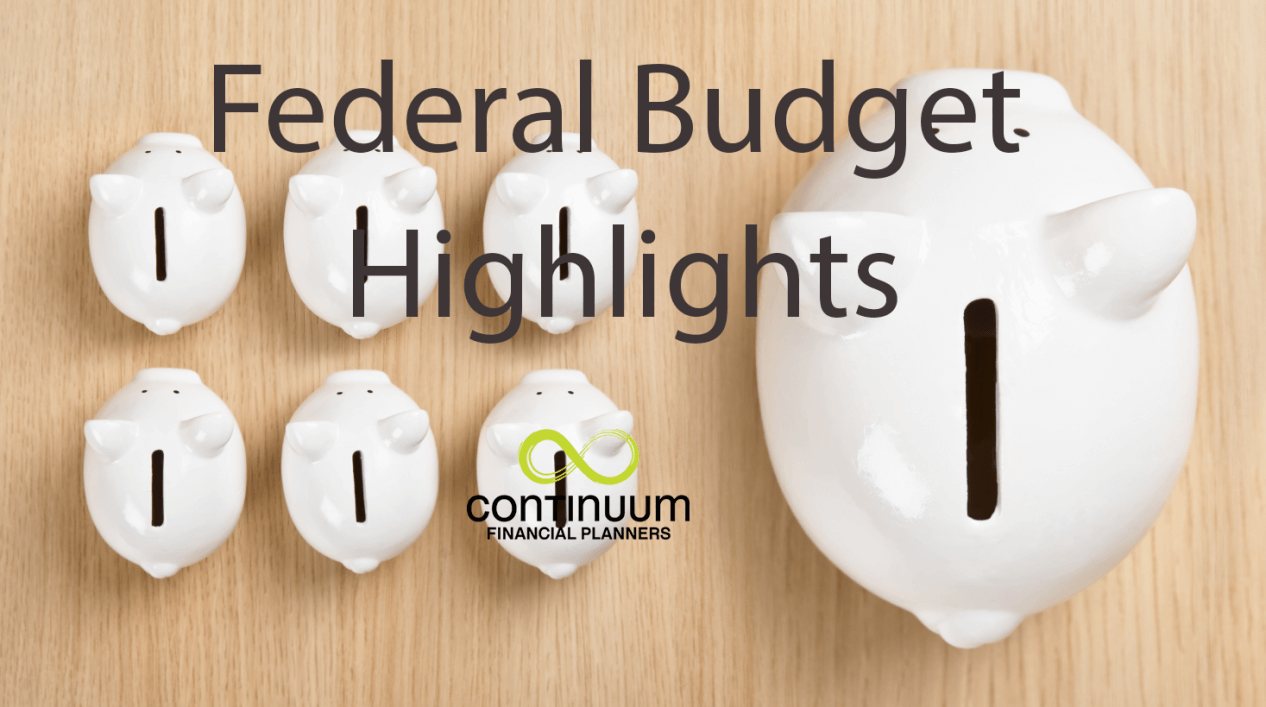Budget highlights 2016 provide a reference summary of the Budget proposals made by the Commonwealth government on Tuesday, 3 May 2016. Within a week of that date the Parliament was prorogued and a double dissolution called. In the process, most of the proposals made in the Budget Papers were not able to be implemented because of the lack of ‘sitting time’. Regardless of this however, the Federal Budget 2016 stands as printed and will be enacted to the extent that the elected government chooses to bring to the Parliament – and that the Parliament agrees to approve.
The following highlights from the 2016 Budget have been selected on the basis of their impact on wealth management, financial planning and financial matters generally with a direct impact on individuals. We set them out under the categories of Superannuation, Taxation, and Social Security (Centrelink).
Continuum Financial Planners Pty Ltd and its team of advisers and support staff regularly monitor the progress of Budget proposals through the Parliament and will be able to assist you to evaluate their effect on your individual circumstances if you engage us to do so. Clients of the firm will have the effects of these measures considered in their ongoing reviews with their appointed adviser.
Budget Highlights 2016: Superannuation
Concessional Contribution cap/ carry forward entitlement
From 1 July 2017, the concessional contributions cap will reduce to $25,000 per year. Currently the concessional contributions cap is $30,000 per year if under age 50 and $35,000 per year if aged 50 and over.
From 1 July 2017, notional (estimated) and actual employer contributions for members of unfunded defined benefit schemes and constitutionally protected funds will be included in the concessional contributions cap.
Where a superannuation account member has a balance of less than $500,000 in all superannuation accounts they hold, any shortfall in the contribution cap can be made up within a five-year period from the year(s) in which the shortfall occurs.
Superannuation Contribution eligibility
The Budget proposes that individuals will be able to make concessional contributions of up to $25,000 per year up to the age of 74 years, without having to satisfy ‘the work test’ that otherwise applies to those over 65 years of age. This measure is proposed to commence as from 1 July 2017.
This removal of the work test requirement also applies to the nonconcessional contribution – see next item.
Lifetime cap on nonconcessional contributions
The Federal Treasurer has proposed that a lifetime cap on ‘after-tax’ contributions to superannuation be set at $500,000. The amount of any contributions made from 1 July 2007 are to be brought to account in determining eligibility to contribute under this measure, with the cap to apply from 7:30 pm on 3 May 2016.
[Note that this measure does not impact the Small Business Rollover Capital Gains Tax concession.]
Cap on funds eligible to support tax-free pension income stream
As from 1 July 2017, it has been proposed that any sum in excess of $1.6 million that is held in a pension account on behalf of any individual, will have to revert to accumulation phase. This cap will be subject to indexation over time, so that superannuation members rolling into pension phase after that date will be limited to the indexed amount applicable at the relevant date.
[Superannuation funds held in accumulation phase are subject to the currently applicable taxation of 15% on earnings, subject to any offset from franking and other credits. Lump sum withdrawals from superannuation accumulation accounts are subject to tax in the hands of the member, subject to existing conditions and provisions.]
Superannuation taxation (the low income super tax offset)
As from 1 July 2017 it is proposed that workers whose ‘adjusted taxable income’ is less than $37,000 will receive a credit to their superannuation account for any tax paid on concessional contributions, up to an individual limit of $500 per year. This measure is referred to as ‘the low income super tax offset’.
Superannuation taxation (Transition to Retirement concession removed)
In the 2016 Budget papers, the government has proposed that as from 1 July 2017, superannuation account balances that support transition to retirement income schemes will be subject to taxation in the same way that all accumulation account income is taxed: that is, at 15%.
[Note: the government has not proposed to tax the pension amount received in the hands of the individual. This measure, together with the reducing concessional contribution cap, will require some transition to retirement pensioners to revise their strategies.]
Budget Highlights 2016: Taxation
Increase to Medicare Levy low-income thresholds
From the 2015-16 financial year, the Medicare Levy low-income threshold will be indexed for individuals and families. The threshold for singles will increase to $21,335 per annum and for couples with no children will increase to $36,001 per annum. For those individuals and couples who are eligible for Seniors and Pensioners Tax Offset (SAPTO) the thresholds will increase to $33,738 per annum and $46,966 per annum respectively. The additional threshold amount for each dependent child or student will increase to $3,306 per annum.
Changing the income tax thresholds
From 1 July 2016, the income threshold where the 37% marginal tax rate starts to apply will increase from $80,001 to $87,001.
| Taxable income threshold (2015-2016) | Tax payable (2015-16) | Proposed taxable income threshold (2016-2017) |
Tax payable (2016-17) | % tax on excess |
| $18,200 | Nil | $18,200 | Nil | 19.0% |
| $37,000 | $3,572 | $37,000 | $3,572 | 32.5% |
| $80,000 | $17,547 | $87,000 | $19,822 | 37.0% |
| $180,000 | $54,547 | $180,000 | $54,232 | 47.0%1 |
1 Including the 2% temporary budget repair levy.
Extending the existing freeze on the Medicare Levy Surcharge and Private Health Insurance Rebate thresholds
From 1 July 2018, the Medicare Levy Surcharge and Private Health Insurance Rebate will remain paused for three more years.
Currently these thresholds are legislated to be paused from the 2014-15 tax year through to the 2017-18 tax year. As a result of this proposal, the thresholds would remain frozen until 30 June 2021. This means that clients earning near or above $90,000 for a single or $180,000 for a family, may expect to pay higher private health insurance premiums or a higher Medicare Levy Surcharge where no approved private health insurance is held.
Negative gearing
The Government has announced officially that they will not remove or limit negative gearing because it would increase the tax burden on Australians trying to invest for their future.
Budget repair levy
On 30 June 2017, the three year Temporary Budget Repair Levy on high income individuals will cease. Up until then the temporary levy will continue to apply at a rate of two percent on individuals’ taxable income in excess of $180,000 per annum. This will mean that the top marginal tax rate will reduce from 49% to 47% from 1 July 2017.
Reducing the company tax rate to 25%
From 1 July 2016, the company tax rate will be progressively reduced to 25 per cent over 10 years. The tax rate for businesses with an annual aggregated turnover of less than $10 million will be 27.5 per cent from the 2016-17 income year. The annual aggregated turnover threshold will then be progressively increased to ultimately have all companies at 27.5 per cent in the 2023-24 income year. In the 2024-25 income year the company tax rate will be reduced to 27 per cent and then be reduced progressively by 1 percentage point per year until it reaches 25 per cent in the 2026-27 income year.
Increasing the small business entity turnover threshold
From 1 July 2016, the small business entity turnover threshold will be increased from $2 million to $10 million. The current $2.0 million turnover threshold will be retained for access to the small business capital gains tax concessions.
Increasing the unincorporated small business tax discount
Currently, individual taxpayers with business income from an unincorporated business that has an aggregated annual turnover of less than $2 million, are eligible for a small business tax discount of five per cent of the income tax payable.
Access to the discount is proposed to be extended to individual taxpayers with business income from an unincorporated business that has an aggregated annual turnover of less than $5 million. The current cap of $1,000 per individual for each income year will be retained.
Budget Highlights 2016: Social Security
Eligibility for the Disability Support Pension (DSP)
The Government proposes that, effective from 3 May 2016 and over the next 3 years, up to 90,000 current DSP recipients will have their DSP eligibility reviewed to assess their capacity to work which is expected to contribute to the new National Disability Insurance Scheme Savings Fund. There will also be up to 30,000 Disability Medical Assessments for current DSP recipients considered high risk of not being eligible for the payment. It is expected that as a result of this review, a proportion of these recipients may no longer be entitled to receive the DSP.
Amending portability rules for para-athletes preparing for the Paralympic Games
Effective as of 3 May 2016, and applying retrospectively from September 2015, it is intended that para-athletes in receipt of the DSP will have up to an additional 4 weeks of overseas travel without their payments being impacted to allow these athletes to attend approved international events leading up to the: 2016 and 2020 Summer Paralympic Games; and the 2018 Winter Paralympic Games.
Changes to the Age Pension Assets Test
One of the biggest changes to affect retirees was announced in the 2015 Federal Budget and has already been legislated. From 1 January 2017 the Assets Test thresholds for the Age Pension will be increased, however, the rate at which assets above the threshold will reduce the Age Pension will increase from $1.50 per fortnight per $1,000 of assets above the threshold to $3 per fortnight.
This returns the taper rate to the same level as applied prior to 20 September 2007. [Other benefits affected by the change include: Bereavement Allowance; Disability Support Pension; Carer Payment; Wife Pension; Widow B Pension; and the Service Pension.
Pensioners with assets below the new thresholds may see their Age Pension (or other benefit) increased. However, if their entitlement is determined by the Income Test, they may not benefit from the change to the Asset Test. Pensioners with assets above the new assets test threshold are likely to have their Age Pension (or other benefit) reduced. In particular, the level of assets at which the Age Pension will cut out will be reduced.
Pensioners who lose their Age Pension (or other benefit) as a result of the changes may also lose their Pensioner Concession Card, however, they may be entitled to another concession such as the Commonwealth Seniors Health Card.
Continuum Financial Planners
If any of the Budget Highlights 2016 issues covered in this article are of interest or concern, our team of experienced advisers is available to help you resolve any emerging wealth management issues: ‘…we listen, we understand; and we have solutions…’. To arrange a meeting with one of our team, phone (on 07-3421456), or use the website Contact Us form. You will receive prompt and courteous attention.
[We acknowledge the input from BT Financial Group Limited and from Challenger Life Company Limited by way of information extracted from reports on the Budget and reproduced in this article.]


